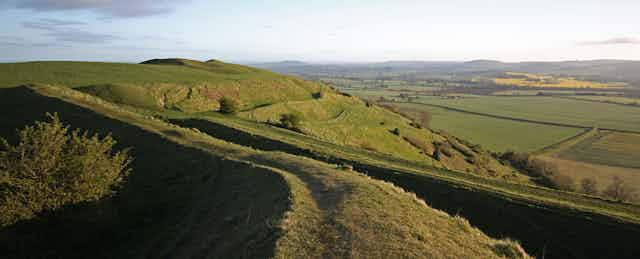It is great news that the National Trust has bought Hambledon Hill, a Iron Age hill fort in southwest England, for the nation. Now the expertise of its in-house archaeologists and conservators can be used to preserve this enormously important site.
Why is this hill north-west of Blandford in Dorset so important? It is a site that has been inhabited throughout many periods of early British history, from the early Neolithic (Stone Age), through the Bronze Age, Iron Age, and into the contemporary (by comparison) record of the Romano-British and later Anglo-Saxons.
After farming arrived in Dorset and Somerset around 4,200BC, an agricultural society developed in the vicinity of Hambledon Hill over five centuries before the immense undertaking of building the enclosures began that would transform the hill into a fort.
The complex was inhabited for 400 years, determined by radiocarbon dating of 160 carefully selected samples. The earliest stage of construction was the main enclosure, dated to around 3,680-3,630BC. A sequence of four periods of building activity followed, with subsequent extensions to the east, south and west continuing through 3,350-3,310BC.
Neolithic ceremonial centre
The Hambledon Hill fort is a physically impressive, societally significant construction that initially faced east across the River Iwerne onto Cranborne Chase and provided defence from that direction. After a period during which the fort appears to have been attacked on at least two occasions, with young men killed by arrowshot, outworks were built to the west that reversed the role of the site. The hill changed from providing defence to the east, and impressing those living there, to asserting power towards the west and the Vale of Blackmore. This may be the first glimpse of shifting power politics in early Britain, more than 5,000 years ago.
At every stage of the detailed investigations of Hambledon Hill, the conclusion has been that while the people had come from farming settlements, Hambledon stood on marginal land, still forested, and certainly not intensively farmed. This was the natural habitat of red and roe deer, marten and badger, whose remains are found on the site. This was border country between populations, relatively remote from settlement.
The evidence suggests periodic, probably seasonal, visitation by large groups of people. They brought with them cattle, pigs and sheep for slaughter and feasting, and ready-processed grain and other foods. Judged by the imported goods, these visitors came from the north and west, from the river Severn and as far as Devon if not further.
Prestigious objects are largely found in the main ritual enclosure, where pits occur with rich deposits. The ditches of this enclosure and its long barrow were repeatedly recut to deposit food debris and objects. Human skeletons occur frequently, sometimes with traces of exposure and defleshing, and skulls are also frequently found. Recurring patterns are everywhere – an extreme example being the burial of two children, each with a possibly inherited skull deformity, in the same segment of ditch but several generations apart.
Once the site was deserted, the Beaker people that came around 1,000 years later recognised and marked the then defunct enclosures. Early Bronze Age fields were laid out, and a Middle Bronze Age settlement was built atop one of the Neolithic enclosures. Later Bronze Age burnt mound activity took place in the Iwerne valley.

A fort for a troubled Age
Eventually, sometime in the middle of the first millennium BC, there was again a need to create an easily defensible fortified habitable centre that could accommodate a large number of people, if only for psychological reasons. Such a fortified centre was built on the northern point of the spur of Hambledon Hill around 600-700BC.
This fortification was apparently succeeded by the main Iron Age phase of the occupation and fortification of Hambledon Hill’s north spur when a defensive ring of multiple ramparts (multivallate) was built on the hill. It remains massively impressive to this day, with highly skilled engineering required to achieve this daunting effect. Some time around 600BC hundreds of relatively tiny round houses were built, seven to nine metres in diameter, originally probably with conical thatched roofs, on carefully dug platforms installed throughout the encloure, until the entire interior was filled with perhaps four or five hundred.
Houses so closely organised and spaced can only have been occupied for a short time. Was this another seasonal meeting place, as it has been suggested the hill was in Neolithic times, 3,000 years earlier? Designed to impress those in the countryside around, it may have heralded the end of a period of relatively untroubled individual farming and the return of more fraught, difficult circumstances.
This fortress-cum-ceremonial centre may have lasted some time before a less remote and more accessible centre was required, probably built on Hod Hill immediately to the south.
Later still a Romano-British field system covered the hill, and an Anglo-Saxon cemetery was set by the parish boundary on the spur towards Stepleton Spur. Oliver Cromwell’s roundheads fought a skirmish here in 1645 against local villagers calling themselves the Clubmen who had banded together against the looting by troops of both sides of the Civil War. And a century later, Colonel (later General) Wolfe exercised his troops there before going onto scale the Heights of Abraham in the Battle of Quebec.
Hambledon Hill is a beautiful part of the Dorset landscape, rich in plants, flowers and wildlife. But it is also a precious looking glass into 5,000 years of British history – hopefully now preserved in perpetuity for the nation.

